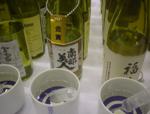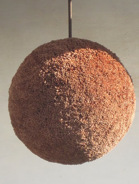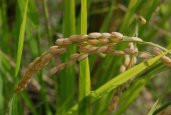|
|
Greetings to all readers,
It is May. While things are still far from stable here in Japan, we are moving toward recovery. This is thanks in LARGE part to the support of everyone around the world. The damage to the sake industry, and the effects it will have, have become clear. Yet very much is still unclear. Since things are changing so fast, it seems best to limit my observations and commentary on the aftermath of March 11 for a bit longer, and as such will report and observe more about that situation next month. Japan, we are moving toward recovery. This is thanks in LARGE part to the support of everyone around the world. The damage to the sake industry, and the effects it will have, have become clear. Yet very much is still unclear. Since things are changing so fast, it seems best to limit my observations and commentary on the aftermath of March 11 for a bit longer, and as such will report and observe more about that situation next month.
Later this month will be the 99th running of the National New Sake Appraisal. It will be an austere one this year, as many breweries from the Tohoku region will not be able to participate. And to boot, it was a very hot summer, leaving us with rice with which it is hard to brew. But it will be interesting to see the results.
Note the official announcemnt of the Sake Professional Course NYC this summer, which is already way ahead of schedule in terms of filling up. If interested, please contact me soon. And be sure to check out the new, improved, audio-enhanced iPhone app The Sake Dictionary, and its new low price. Enjoy the newsletter!
Warm regards,
John
 
|
Smooth 'em Over, or Let 'em Be
Year to year differences in rice
One of the biggest and most significant differences between sake and wine is the variance from year to year of what ’s in the bottle. At one end of that spectrum, wine celebrates and make the most of the differences from year to year. Better vintages taste better, sell for more, and generate anticipation excitement in the industry.
Sake, on the other hand, seems closer to the way champagne houses work to create a house style and maintain that. So, yes, there are differences in the quality of rice harvests from year to year. But with so much manhandling of the raw materials once they get to the kura (brewery), brewers can and do tweak and adjust to create a sake that for the most part conforms to a style - a particular flavor and aromatic profile that can include weight, viscosity, nuances, acidity and more - and they strive to maintain that. Why? So that whenever a consumer goes to buy a particular junnai ginjo (for example) they get what they expect, what they know and love. There is little risk involved.
Do they achieve this? Yes, for the most part. In general, the larger and more stable the brewer, the more such resolute consistency is expressed in their sake. Dependable is the key word, here. The smaller the brewer, the more you will see changes from year to year, an unavoidable result of limitation of scale. But hey, many folks find this the more interesting and romantic of the two extremes. And note: they are extremes. There is plenty of gray in between them. There are many, many medium-sized brewers that have excellent stability as well, if not as predictable as the largest operations.
So, firstly, remember that sake brewers try to maintain consistency from year to year for a given product. Sure, they might add new products, or even deliberately change them. But without a warning, or without an obvious reason, one would not expect a huge change.
Teetering on edge of a tangent for a moment, if that is the case, why taste ‘em again? Why go back (at tastings or professional events) and taste sake you have already experienced? I mean, it should be the same right? So... why go back again? Because it’s more a matter of looking at how better or worse (heaven forbid) a given sake is within that framework of what you expect. Sure, it should be close, yes. But like all things sake (or Japanese, for that matter) it is those minute differences from year to year - nay, verily from bottle to bottle - that make all the difference. Don’t get me started…
There are countless other reasons to retaste. To polish and improve tasting skills, to confirm the nature of a given product and embed it in your psyche, to create that internal database of sake profiles, to get better at discerning that there indeed are minute or subtle differences from year to year. (Or, you could get a life. I myself no longer have that option; but I digress.
At tastings it seems like I am always going around assessing a sake on what I think it should taste like based on what I know about the product and the kura behind it. And it is rare to come across a brewer who will warn you before tasting that two bottles from two consecutive years are completely and totally different sake, despite being the same labeled product.
And yet, this is what I came across at a recent tasting of up-and-coming brewers. The brewer of Hakuin Masamune from Shizuoka, Takashima Shuzo, had a yamahai junmai from two consecutive seasons. Most brewers would blend the remains of one year with the first tanks of the next to ensure a smooth transition in the eyes and palates of consumers. But not this guy. Nah. He chose to exacerbate the difference."
"Zenzen chigau,” he began. “They are totally different. Totally!” Intrigued, I asked why before I tasted.
"The rice, man, the rice. If you recall, this past growing season was extremely hot and dry. So the rice was hard, dissolved only grudgingly, and wouldn’t ‘give it up’ for us. So it’s very dry and simple. Great for that style! "
"But the year before was much cooler, and the rice dissolved and bro ke down quite readily for us, giving us tons of flavor and sweetness.” From experience, brewers can predict how the weather will affect the rice, of course. While most choose to try to smooth those over, here, Takashima-san’s place went with the flow and made the most of what nature gave them. “Check it out!” he encouraged. And so I did... ke down quite readily for us, giving us tons of flavor and sweetness.” From experience, brewers can predict how the weather will affect the rice, of course. While most choose to try to smooth those over, here, Takashima-san’s place went with the flow and made the most of what nature gave them. “Check it out!” he encouraged. And so I did...
Of course, he was right. The first year was very tight, little breadth, and dry. But those three aspects worked well together and created a balanced sake. The other one was rich, heavy, sweet and gamy as a good yamahai should be. Yet still, all this precariously balanced around a point of origin deep within the chaos. It was a wild ride but delicious.
So, yes: sake should be consistent from year to year. It is supposed to be. Not perfectly so, but essentially so. And at the same time remember there are those that do not fit the mold, or just wing it and go with the flow and make the most of what the rice is and can do from year to year. Yet, ironically, it is those differences, those non-conforming touches that add depth to the appeal and allure of sake. Learn to discern them and sake becomes exponentially more interesting.
Both have a place in the sake world, so please enjoy the two extremes, and all that lies in-between. |
 Did You Know? Did You Know?
Did you know? Kudari-zake
Kudari-zake is a term we do not hear any longer, except perhaps in historical references. It serves to remind us just where the breadbasket - er- rice bowl - of sake production has historically been, and remains today
In short, kudarizake refers to sake brewed in the western part of Japan, specifically, Kyoto and Hyogo, that was sent up by sea or land to Edo. Those brewing regions included Fushimi in Kyoto, Nada straddling the cities of Kobe and Nishinomiya, and regions a bit west of that too known as Harima. And Edo, of course, was the old name for what is Tokyo today.
From  about 1600 until 1868, the Shogun in Edo had all the heavyweights of the outlying regions spend every other three year period in Edo, under his watchful eye, minimizing (but not eliminating!) scheming in the countryside. That meant lots of thirsty samurai in town. A lot. And the best sake at that time, by far, was brewed in the aforementioned western regions. Sake shipped up from that area was known as kudarizake. Literally, it means"sake sent down." about 1600 until 1868, the Shogun in Edo had all the heavyweights of the outlying regions spend every other three year period in Edo, under his watchful eye, minimizing (but not eliminating!) scheming in the countryside. That meant lots of thirsty samurai in town. A lot. And the best sake at that time, by far, was brewed in the aforementioned western regions. Sake shipped up from that area was known as kudarizake. Literally, it means"sake sent down."
To get to Edo, it had to go north east. So, why was sake that was going up known as sake sent down? Because the Emperor at that time lived in Kyoto, out west. As such, the area was known as "kamigata," or "the hight place." Naturally, everything sent from there could at least potentially be referred to as having been “sent down” from the high place near the Emperor.
Yes, lots of fine sake was brewed near Edo. But the sake sent down from the high place had the best reputation. And that helped the region grow to be the largest sake-producing region in Japan, by far.
So, the next someone asks you, "Did You Know?" you can answer, "Why, yes, I did know." |
 Sake Basics Sake Basics
Fruity Aromas From Rice? When approaching one's first ginjo or daiginjo, it is not uncommon  for someone to do an olfactory double-take. “What the… Banana? Melon? Apple? Strawberry even! How does this…” they exclaim, incredulously poking a finger toward the top of a glass of sake,” come from rice? Huh?” for someone to do an olfactory double-take. “What the… Banana? Melon? Apple? Strawberry even! How does this…” they exclaim, incredulously poking a finger toward the top of a glass of sake,” come from rice? Huh?”
The answer is yeast. Sake yeast takes the sugars and other compounds that come from the rice and ferments them to reveal a whole host of aromatic compounds like esters and more that give us that alluring array of fruit and more. No, they do not add anything. No, it has nothing do with fruit nearby the rice fields or kura. No, it is not modern engineering. It is more like ancient craftsmanship.
A line to remember: more than anything else, yeast contributes to aromas, and more than anything else, rice leads to flavor. |
 Announcements and Events Announcements and Events
Sake Professional Course in New York City

July 31 ~ August 2, 2011
"No sake stone remains left unturned."
The next stateside running of the Sake Professional Course will be held at Astor Center in New York City on Sunday, July 31 through Tuesday, August 2, 2011. The course will run basically 9 to 5 all three days, and will conclude with certification testing for the Certified Sake Specialist, recognized by the Sake Education Council. For more information go here . Feel free to ask me any questions about the course, or make a reservation with an email to info@sake-world.com.
Sake Education Council Website is Live!
Please take a moment to check out the newly completed website for the Sake Education Council, the organization behind the Certified Sake Professional and Advanced Sake Professional certifications. We plan to grow steadily, strongly and continually, and we will need the support of all those that love sake to do so. Follow us through the "usual suspects" of social media.
Sake Homebrewer's Online Store
Please be sure to check out Homebrewsake.com for supplies, information and a forum, including lots of supporting information on everything from recipes to history. I have been meaning to mention this site and the gentleman behind it, Will Auld, but have repeatedly forgotten in past newsletters. The site is replete with instruction, augmented with videos, schedules, and more. If you are even remotely interested check this site out right away.
Don't forget the archives!
Older editions of this newsletter are archived here.
Really old editions are archived here.
|
 Sake Education Central Sake Education CentralThe Sake Dictionary App for the iPhone and iPod
Newly improved, now with audio, and drastically reduced in price to $0.99!
There you are, perusing a menu, or standing in front of a shelf of great sake, or perhaps reading a sake newsletter… and up pops one of those hairy, pesky sake terms in Japanese. You know you have heard it many times, but dammit, you just cannot remember what it means now…
No problem! Just whip out your iPhone or iPod and fire up your trusty old version of The Sake Dictionary. In a matter of seconds, you’ll be amongst the cognoscenti once again. But… if only you could pronounce it properly. Now that would really rock!
Done! Just tap on the term and you will hear a clear example of how to pronounce the term in Japanese. Repeat it a couple of times and the term is yours for eternity, to toss about and impress your mates.
What’s more, it’s less! Less than what it cost before, much less. Like less than one-seventh less. For a limited time only, the audio-enhanced version of The Sake Dictionary iPhone app is available for a mere $0.99.
The Sake Dictionary is a concise little package of all the terms you might ever come across when dealing with sake. Almost 200 of them - including sake grades, rice variety names, seasonal sake terms, special varieties, rare types, post-brewing processing words and the myriad terms used in sake production - many of which are not even familiar to the average Japanese person on the street - are listed up here with concise, useful and clear definitions and the written Japanese version as well. And now, with the new audio component, you can listen and learn just how to pronounce those terms properly.
Start to toss around Japanese sake terms like you were raised knowing them! Gain a level of familiarity hitherto unimaginable! Avoid frustrating paralysis when faced with a sake-related purchase!
Get your copy of The Sake Dictionary now and never be confused by sake terms - or how to pronounce them - again.
Get it here: http://itunes.com/apps/sakedictionary
(Note if you have already purchased it, this upgrade to the audio version is free. Just go to iTunes and get it!) |
Stay Subscribed!
Are you not getting this newsletter? I realize that is like asking that "those not present please raise your hand," but for future reference, should you spontaneously stop receiving this newsletter, please go here and sign up again. Should that not work, please go to www.sake-world.com.
Email newsletter services are very careful not to be considered spam enablers, but the problem is that often very valid email addresses come back bounced as invalid. It is an unavoidable problem. So if you or someone you know is not getting this, or stop(s) receiving it inexplicably, please do take a moment to double check that you are still subscribed.
Sincere apologies for the hassle, mixed with gratitude for reading this newsletter.
|
I hope you have found the above information helpful and entertaining. For more information about all things sake, please check out www.sake-world.com. Until next month, warm regards, and enjoy your sake. 
Questions and comments should be directed to John Gauntner, at this email address.
All material Copyright, John Gauntner & Sake World Inc.
Regards,
John Gauntner
Sake World, Inc
 . . 
| |
